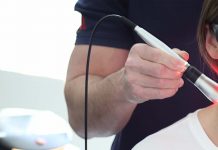KAMRA Inlay is an eye surgery for treating impaired near vision caused by presbyopia. It involves implanting a small, ring-shaped device into the cornea to allow focused light to pass through to the retina to enhance near-vision acuity. This procedure is specifically for people who experience age-related vision changes. They have no significant refractive error for distance but are presbyopic and need reading glasses or multifocal.
Presbyopia is the typical worsening of vision that affects aging people as they age. As several people approach middle age, their eye lenses lose elasticity, and the muscles surrounding them weaken. These changes gradually impair your ability to focus, particularly on close objects.
Presbyopia makes it tough to read, write, and perform other tasks that require close vision. In addition, the lenses lose flexibility, making it challenging to bend enough to bring near objects into focus. As a result, images are focused behind the retina instead of directly on it, leaving close vision blurred.
Understanding Kamra Inlay Technology
Kamra Inlay creates a small opening in the cornea; the eye’s transparent outer layer. It places a small, donut-shaped ring on the opening. This ring has a small aperture in the center, allowing only focused light to pass through to the retina while the surrounding area filters out unfocused light. Doing so helps the eye focus on nearby objects, improving near vision.
One of the most significant benefits of Kamra Inlay is that it is minimally invasive, which means it does not require removing any significant amount of tissue from the eye. In addition, it is mainly performed as an outpatient procedure, which means you can return home the same day.
Moreover, it does not require a lengthy recovery period. However, some patients may experience slight discomfort or dryness in the eye, which usually subsides within a few days. Kamra Inlay is an effective treatment for improving near vision in patients with presbyopia.
In addition, the KAMRA is suitable for long-term implantation due to its microscopic openings that allow oxygen to flow freely to and from the eye’s surface. However, it can be removed if the patient no longer wants it.
Recent Advancements in Kamra Inlay Technology
The procedures for correcting age-related decline in the eye’s ability to focus on near objects called presbyopia have revolutionized over time. One of these procedures is the Kamra Inlay technology. Kamra inlay technology has evolved in its design and implementation to ensure better results and effectiveness. As a result, it has become a highly effective technique adopted in the treatment of presbyopia.
Kamra inlay technology has seen significant advancements in recent years, allowing for greater precision and better visual outcomes. One of the most notable enhancements is how the manufacturing process has become more precise and accurate. Another exciting development is that the upgraded inlay design provides better visual outcomes, with improved depth of focus and fewer side effects.
Overall, these advancements in Kamra inlay technology provide patients with more effective and comfortable treatment options for presbyopia. In addition, advanced laser technology is now used during the implantation procedure, allowing for more precise and accurate inlay placement and better patient visual outcomes.
How Kamra Inlay is Redefining Presbyopia Treatment
Due to aging, there is a natural decline of the eye that leads to the inability to focus on near objects; this experience is called presbyopia. Presbyopia can lead to a dependence on glasses or contact lenses to read or see things up close. However, the development of Kamra Inlay technology has provided a new and long-lasting solution to this problem.
A tiny disc-shaped device called karma inlay is implanted in the eye’s cornea, the eye’s clear front surface. As soon as this implantation is done, the inlay blocks some unfocused light that enters the eye, allowing a better focus and improved near vision.
Compared to other presbyopia treatments, Kamra Inlay provides a long-lasting solution. Once the doctor implants the inlay, patients can enjoy improved near vision without needing glasses or contact lenses.
Overall, Kamra Inlay is a more convenient option for many patients as they can often return to their routine the day after the procedure, unlike other types of surgeries that may require more downtime. Although Kamra Inlay may not be suitable for everyone, it’s an excellent option for those looking for a long-lasting solution to presbyopia and wishing to reduce their dependence on corrective lenses.
Kamra Inlay: A Game-Changing Solution for Presbyopia
Kamra Inlay technology is a minimally invasive procedure that can enhance near vision. It has solved the hassle and frustration that comes with dependence on lenses. This exciting and innovative solution for presbyopia treatment provides a long-lasting alternative to traditional therapies like glasses or contacts.
Kamra Inlay’s implantation is relatively quick and has a speedy recovery time, making it the best bet over several other types of surgery. The recent advancements in its design and implantation techniques make it a safe and effective alternative to traditional treatments. You can typically return to your daily business a day after the procedure.
Considering the improved optical design and the adoption of advanced laser technology, Kamra Inlay is a game changer in presbyopia treatment. In addition, its small size makes it a more comfortable and discreet option for individuals, and its long-lasting benefits make it a cost-effective solution in the long run.















